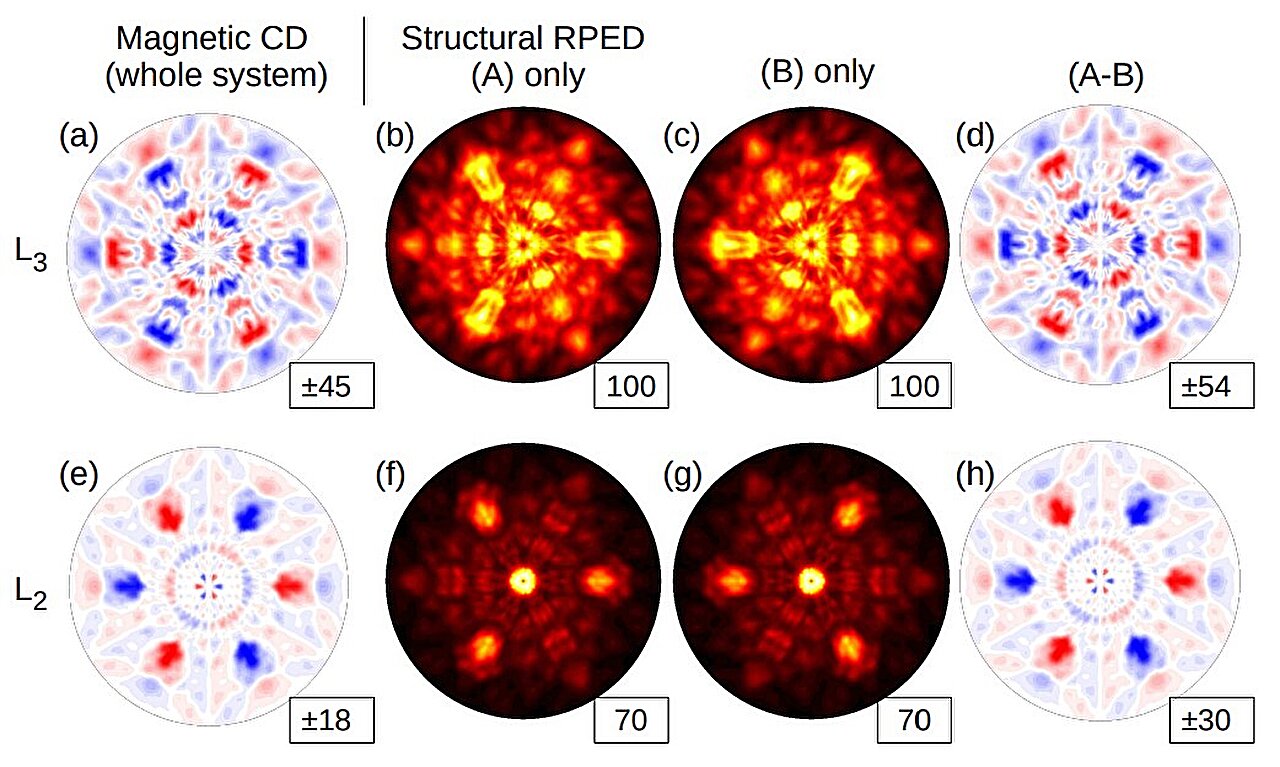![Calculated RPED patterns of MnTe for circular po-larized light with helicity q || L~ [1100] at the L3-resonance ( hbar omega = 639.7eV a-d) or the L2-resonance ( hbar omega = 651.8eV e-h). Credit: Physical Review Letters (2025). DOI: 10.1103/pl1p-v5rs Two new tools to map and measure the invisible properties of altermagnets](https://www.newsbeep.com/ca/wp-content/uploads/2025/11/two-new-tools-to-map-a.jpg)
Calculated RPED patterns of MnTe for circular po-larized light with helicity q || L~ [1100] at the L3-resonance ( hbar omega = 639.7eV a-d) or the L2-resonance ( hbar omega = 651.8eV e-h). Credit: Physical Review Letters (2025). DOI: 10.1103/pl1p-v5rs
The new big thing in magnetics is altermagnetism, a form of magnetism that promises to power the next generation of electronics. Unlike ferromagnets, like a fridge magnet, where all internal atomic spins align to create a strong magnetic field, altermagnets have no net magnetic pull (strongly magnetic on the inside, but appears non-magnetic on the outside). This is similar to antiferromagnets where internal spins cancel each other out. However, altermagnets retain powerful internal properties that could let them carry and control information more efficiently than traditional magnets.
Because this magnetism has a zero net pull, it is hard to detect using standard measurement tools. In two new papers, researchers detail how they have developed X-ray techniques to map and measure different aspects of an altermagnet’s internal structure.
Mapping magnetic domains
In the first paper, published in Physical Review Letters, scientists developed an advanced X-ray method called RIXS-CD (Resonant Inelastic X-ray Scattering-Circular Dichroism). Older X-ray techniques struggle to reliably map and distinguish the magnetic regions (or domains) in an altermagnetic, but when the team rotated a sample of an altermagnetic material under an X-ray beam, it created a unique magnetic fingerprint for each domain. This allowed them to make precise maps of these magnetic domains.
“RIXS-CD detects the unitary (space) symmetry breaking via T-breaking magnetic orders. This makes RIXS-CD a complementary technique to XMCD, with potential applications to a wider class of anomalous Hall antiferromagnets, including the noncollinear ones,” wrote the researchers in their paper.
Measuring strength
In the second paper, also published in Physical Review Letters, Peter Krüger from Chiba University in Japan proposes a new technique, CD-RPED (Circular Dichroism in Resonant Photoelectron Diffraction), to measure the magnetic strength of a single, invisible atomic layer.
This technique works by aiming X-rays at the atoms in an altermagnetic material (AM), which forces them to emit electrons. The surrounding magnetic layers affect these electrons, creating a unique pattern (an echo). Measuring this echo allows the scientists to quantify the magnetic properties of each hidden atomic layer. “Our main findings are valid for any AM and lay the ground for making CD-RPED a powerful technique for the magnetic characterization of AM candidate materials.”
Thanks to these two techniques, altermagnetism is no longer invisible. Scientists will be able to map and measure its hidden properties to understand how this form of magnetism behaves and quantify its strength. This could help accelerate the next generation of spin-based computing technologies, leveraging the intrinsic spin of electrons to perform computations.
Written for you by our author Paul Arnold, edited by Gaby Clark, and fact-checked and reviewed by Robert Egan—this article is the result of careful human work. We rely on readers like you to keep independent science journalism alive.
If this reporting matters to you,
please consider a donation (especially monthly).
You’ll get an ad-free account as a thank-you.
More information:
D. Takegami et al, Circular Dichroism in Resonant Inelastic X-Ray Scattering: Probing Altermagnetic Domains in MnTe, Physical Review Letters (2025). DOI: 10.1103/512v-n5f9
Peter Krüger, Circular Dichroism in Resonant Photoelectron Diffraction as a Direct Probe of Sublattice Magnetization in Altermagnets, Physical Review Letters (2025). DOI: 10.1103/pl1p-v5rs. On arXiv: DOI: 10.48550/arxiv.2504.08380
© 2025 Science X Network
Citation:
X-ray techniques map and measure the invisible properties of altermagnets (2025, November 10)
retrieved 10 November 2025
from https://phys.org/news/2025-11-ray-techniques-invisible-properties-altermagnets.html
This document is subject to copyright. Apart from any fair dealing for the purpose of private study or research, no
part may be reproduced without the written permission. The content is provided for information purposes only.

